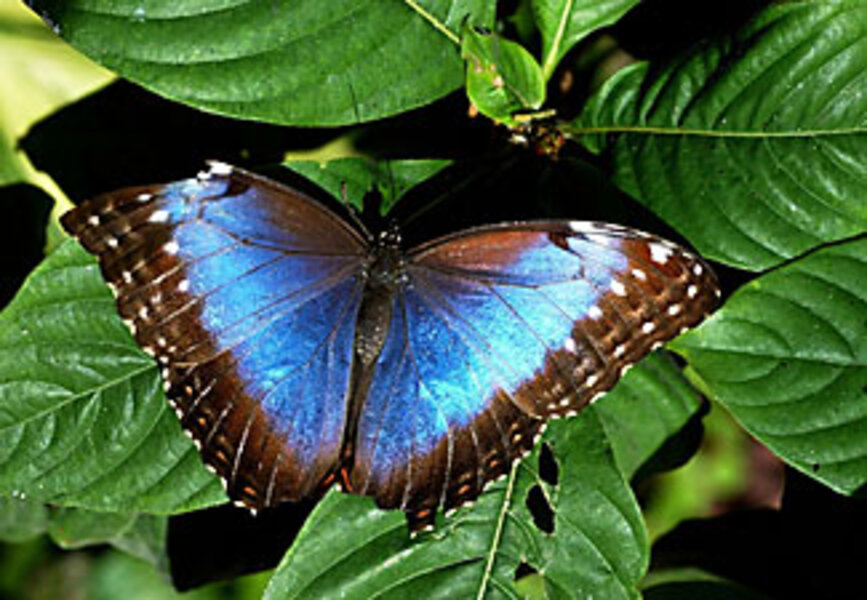On the trail of the blue butterfly
Loading...
Someone once said that in small countries you should expect small attractions. Not true. Yet, while visiting Costa Rica my attention was first seized by something hardly immense: a blue morpho butterfly in a lepidoptery garden at the national museum in San Jose, the capital. It flittered toward a sky of brilliant blue, which proved no match for the electric blue of the moth. It, and scores of its kind, shared the garden with orange monarchs and butterflies of other shapes and color, diaphanous creatures, some with transparent wings, others ivory-colored, or red, all living under a fine net of black saran, high as a carnival tent.
A caretaker, who puts out bananas for the butterflies and knocks down spiders' webs strung to trap them each day, revealed an array of butterfly pupas in a cabinet, new cohorts about to begin lives of only two or three months duration.
For two weeks I followed the blue butterfly through this Central American country, into its forests, over its precipitous mountains, to the edge of the active Poas volcano that was spewing gases (nothing small about that!), and on to the Pacific beaches. Everywhere it fluttered before me, occasionally the real thing, otherwise an image apparent only to the eyes of my mind.
The butterfly, metamorphosing from egg to larva to pupa (chrysalis), then into an incandescent creature as gorgeous as it is fragile, seemed to represent the country itself.
Didn't Costa Rica evolve into something better – from a banana republic into what my guidebook describes as "the glittering gem of the world's environmental movement"?
How did this come about? It seems that following the coffee market's collapse some 30 years ago, the country's leaders devised a plan to attract foreign tourists. And just what did Costa Rica have to offer? Those rain forests, the animals and flora within them, the grandeur of its beaches, and its congenial citizenry. Thus evolved the Green Revolution.
Over those past 30 years, more than one-third of the country's territory came under government protection. Hundreds of thousands of visitors came to fly on the famous zip lines from tree to tree through the forest. More have tramped the dense trails below, spying toucans and photographing frogs dressed in enamel green, yellow, and red skin.
The dappled forest overwhelms and inspires unexpected thoughts.
In the Carara Biological Reserve, we saw through the thicket, a family of anteaters determined to reduce the forest's population of leaf cutter ants. A quarter of a mile later, we glimpsed a foraging peccary.
On our way south to Jaco beach, we stopped by the bridge over the Tarcoles River and saw crocodiles lying inert on the mud flats. One had its jaws wide open, allowing a small bird to enter and exit, probably to feed on the little bits left over from the croc's last meal.
Nearby, white zebu cattle grazed. I wondered if they ever fell prey to the croc's frightening swiftness.
To get to Jaco beach, we crossed the Cordillera de Talamanca mountain range on a road steep and dark – darker still when a cloud engulfed us. Our driver, Carlos, familiar with this tortuous way, followed the red lights of a truck, which now and then sank into obscurity, like those of a retreating wild animal.
At Atenas, the mountains – draped in wet, spongy moss – stepped out of the cloud. Here, we found ourselves in a vertical region of modest farms and more white cows. In the distance, the Pacific Ocean glittered, the western ocean – as I usually think of it – presenting its underside, the southern sea. I felt a bit like Vasco Núñez de Balboa, the Spanish explorer.
We arrived in Jaco in the dark and found our rented house with ease, not necessarily a simple task because Jaco eschews street numbers and addresses, in common with everywhere else in Costa Rica.
Jaco is the fastest growing town in the country, with condos and hotels rising in a tumult of construction along its beach. Once a destination for surfers and others seeking quiet remove from urban life, it has become favored by foreign retirees, mostly Americans. The logos and signatures of corporate America abound: KFC, Quiznos, Subway. English is the second language. Billboards promise bliss to the foreigner, in the foreigner's language: "A life of luxury in paradise."
But "paradise" is usually behind a gate. Jaco is full of gated developments, hotels, and houses, guarded by uniformed security men and miles of sharp razor wire.
Although I saw no butterflies in Jaco, I found them again at the Butterfly Farm's flower garden in Alajuela, Costa Rica's second largest city.
At the garden, the air was alive with their iridescent presence. These butterflies are protected and sometimes exported to the United States, Europe, Canada, and Australia, as well as to natural history museums and zoos.
Agnes Rodriguez, our guide, lives in happy fascination of the winged creatures. "What's the purpose of butterflies in nature?" I asked. For a moment, her face became contemplative. "It's main purpose in life," she said, "is to provide food for other creatures. It's eggs, itself."





